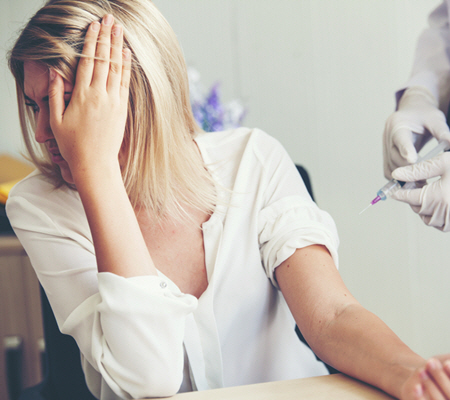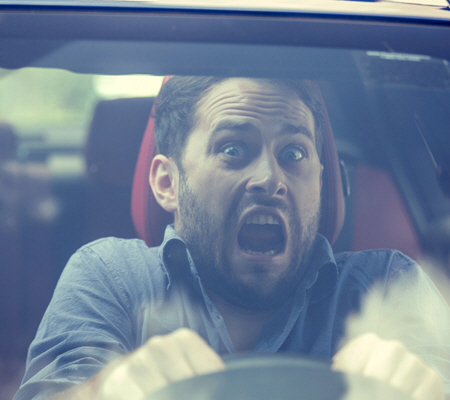 Many circumstances can cause a phobia.
Many circumstances can cause a phobia.
A phobia is a physiological fear response to something in the environment that the person experiences every time they are exposed to it.
For some, it even can be triggered by thinking about that condition or by something that reminds them of a similar circumstance, such as a similar sound, image, or smell.
Specific phobias occur when circumstances or settings trigger an extreme fear response, similar to one that occurs in the face of a mortal threat.
Some examples of specific phobias are flying, driving, spiders, escalators, dogs, needles, being in water, heights, or being in enclosed spaces like trains.
What are the symptoms?
They typically involve a feeling of extreme panic or fright, rapid heart rate, difficulty breathing or rapid breathing, a tightening feeling in one’s chest, sweats, and other changes that are part of the fight/flight response.
People also can experience fear of having these panic symptoms, which also can bring on the symptoms.
 Phobias result from negative experiences.
Phobias result from negative experiences.
A person can develop a phobia through a traumatic or very frightening experience that created an association between some aspect of that experience and a perceived threat.
For example, if as a child someone had difficulty in the water where they felt they couldn’t keep their head above the water and nearly drowned, they may come to associate water with their extreme fear reaction.
Even after they have learned to swim, their brain still associates water with extreme threat. Every time they enter the water for a swim, their body and brain get triggered into an extreme fear response as though they are about to drown, despite their knowing logically that they can keep their head above water.
Phobias have a physiological underpinning.
During the phobic response, the brain has learned to release high levels of stress hormones like adrenaline and cortisol.
Adrenaline tells the heart and breathing to greatly speed up in order to get needed oxygen to the cells throughout the body so that it has the strength and energy to either fight or run. Cortisol regulates blood sugar and metabolism in the body to ensure that it has the energy for the increased demand involved in a threat response. Cortisol also helps with memory formation.
The part of the brain in charge during an extreme fear response is the primitive/emotional limbic brain consisting of the amygdala and hippocampus. These responses evolved over hundreds of thousands of years before the advent of civilization to help us survive in the face of daily danger. Through natural selection the early humans developed the fight/flight response, which is the predecessor to phobia and anxiety.
During a phobic episode, the logical part of the brain is shutting down and the emotional/primitive brain has taken over. In that moment, it wants us to survive and is telling us that a herculean physical effort is needed. A phobia is created when the brain learns this response and repeats it each time it is exposed to that situation.
Two methods are effective for treating phobias.
While there are many different treatments out there that try to address phobia, Dr. Bob offers methods that work directly on the brain and the way it holds the information from that original experience from which it learned to be phobic.
These methods are called Visual-Kinesthetic Dissociation and Eye Movement Integration and will be described in more detail in the part of this site dealing with trauma.
For a description of the evidence on V/K Dissociation, click this link:
While it is not known exactly how or why these methods work, it is believed that they help the brain reconsolidate or re-process the original scary experience from the primitive part of the brain (Amygdala) over to the logical part of the brain (Neoortex & Prefrontal cortex), which is responsible for logical thinking and problem solving.
 What would we do in our sessions?
What would we do in our sessions?
First, we will verify if you are able to trigger the phobia through briefly imagining it. Once it’s clear that you can trigger it, we’ll do the procedure and repeat it until you can do it with ease.
At no time will this procedure involve exposure, reliving, or retelling of the phobia. You will be helped to visualize yourself in a movie theatre with a movie of yourself watching a younger you, all the while with a feeling of complete security that Dr. Bob helps you maintain.
Sessions are designed to help overcome the phobia.
After we do the procedure, we test to see if the phobia can still be triggered.
When you are no longer able to trigger your phobia through imagining being in that circumstance, we will know that the method has worked, your phobia is resolved, enabling you to live a normal life without that fear.
The whole process takes between 3-5 sessions, including a preparatory session and a follow-up session.
Permanent relief is possible.
It has been permanent in every reported case thus far.
Results, while not guaranteed, have been most encouraging!
We offer a free 20-minute phone consultation. Please call (917) 720-6086 and get started today.

